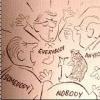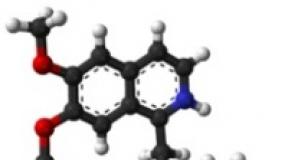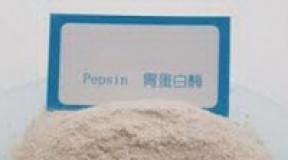Nasonex - relieving baby's breathing with nasal congestion. Nasonex instructions for use, contraindications, side effects, reviews Nasonex indications
A nasal congestion in a child can be caused not only by acute respiratory infections, but also by allergies. One of the most common drugs for the treatment of allergic rhinitis - Nazonex. It is a local hormonal anti-inflammatory and decongestant agent.
How does the medicine work? How to properly spray it in the nose for allergies, sinusitis or nasal polyposis? Does the remedy help with childhood adenoiditis? Find out about it from our review. And at the end, you will find parental reviews about the drug.
Nasonex is a local hormonal drug with anti-inflammatory and anti-allergic activity.
Composition and action of the drug
Nasonex is a hormonal agent for the treatment of allergic rhinitis and nasopharyngeal edema in children.
The drug has a complex effect on the body:
- anti-inflammatory;
- antiallergic;
- decongestant;
- antitoxic.
It is based on the active active ingredient Mometasone, a synthetic analogue of glucocorticoid hormones, which are produced in the human body by the adrenal glands.
The biological role of these substances is great. Glucocorticoids are involved in metabolic processes, regulate blood sugar and stimulate digestion, regulate the immune system and suppress inflammation.
Getting on the nasal mucosa, the drug inhibits the production of inflammatory mediators - biologically active substances that trigger a chain of reactions leading to pain, redness, swelling and dysfunction of the nasal mucosa.

The medicine improves the quality of life of the little patient: he breathes through his nose and sleeps normally.
The product quickly and effectively blocks acute and chronic allergic reactions and, if used correctly, relieves tissue edema and facilitates nasal breathing in a child.
Nazonex acts only at the local level, therefore, the systemic effect and most of the side effects of glucocorticosteroids (decreased immunity, metabolic disorders, weight gain, etc.) are excluded.
Indications
Many mothers are afraid of the term "hormonal" in the description of the drug. This is in vain: of course, the use of Nazonex with a banal rhinitis, when the baby has snot of a viral or bacterial nature, is unjustified, but in some cases they cannot do without intensive treatment.
The medicine is prescribed for the prevention and treatment of various diseases.

The main reason for prescribing a spray is a chronic allergic rhinitis.
The positive clinical effect of the drug has already been observed within twelve hours. after the first application and continues throughout the entire course of treatment.
Nasonex with adenoids
Adenoids are a common childhood disease associated with overgrowth of the pharyngeal tonsils - small areas of lymphoid tissue located behind the nasopharynx. Usually this pathology is associated with frequent infections respiratory tract, and its typical manifestations are a violation of nasal breathing (the baby is forced to breathe through the mouth), snoring and adenoiditis - a sluggish inflammation, accompanied by a slight rise in body temperature, a feeling of fatigue, mucous or mucopurulent discharge from the nose.
Although there is no information in the instructions for use () on the use of Nasonex for the treatment of adenoids in children, many pediatricians and ENT doctors prescribe this drug to their young patients to reduce the swelling of the pharyngeal tonsils and facilitate breathing. The course of treatment and dosage are selected by a specialist individually.
The use of the drug for adenoids allows you to achieve good results: due to the anti-edematous and anti-inflammatory action of Nasonex, the pharyngeal tonsils are reduced, and the baby's nasal breathing is fully or partially restored. The literature describes cases complete cure diseases of mild or moderate severity.

When using the medicine, regular consultations of an ENT doctor are required.
Note! The use of a hormonal drug should be carried out under the strict supervision of a physician. If during treatment the adenoids do not shrink and the baby does not get better, see your doctor again.
Release form
Produced by Nazonex pharmaceutical company Schering-Plugh Labo N.V. in Belgium. The only form of release is metered spray. The term "drops" (some people ask Nasonex drops in pharmacies) in relation to the drug is incorrect, since it is impossible to use it without a special dispenser-spray, simply by instilling it into the nasal cavity. Uniform distribution of a certain dose of Nazonex will allow you to achieve maximum effectiveness and avoid overdose.
The medicine is produced in the form of a suspension - a suspension of Mometasone powder in a solution of excipients (distilled water, glycerol, benzalkonium, etc.). The drug is a white or almost white liquid with no particular taste or smell. 1 g of the drug contains 500 mcg of Mometasone. 1 dose (sprayed into the nasal cavity by pressing the valve once) according to the instructions, contains 0.1 g of the drug and, accordingly, 50 μg of the active ingredient.

Convenient form of drug release.
Suspension Nasonex is sold in a plastic bottle with a dosing valve and a safety cap. The drug is produced in volume:
- 10 g (60 doses), average price - 445 rubles;
- 18 g (120 doses), average price - 800 rubles.
Method of administration in children
Nasonex can only be used as directed by a doctor. Observe the following rules:
- Before the first use, you need to “calibrate”: press the dosing device several times until the suspension starts spraying from the neck of the bottle. Now, each press of the valve will release about 100 mg of the drug (50 mcg of pure mometasone) - 1 standard dose.
- If more than 14 days have passed since the last use of the product, the “calibration” procedure will have to be repeated.
- Shake the medicine bottle thoroughly before each use so that the active ingredient powder does not settle on the bottom.

Before using the spray, rinse your nose with salt water and ask your child to blow their nose.
| Disease | Child's age | Method of use (the indicated dosage is instilled into each nostril) | A course of treatment | |
| Allergic rhinitis | Therapy | 2-11 years old | 50 mcg (1 dose) once a day | The entire period of contact with the allergen |
| Over 12 years old | 100 mcg (2 doses) once a day until symptoms disappear (sneezing, nasal congestion, mucous discharge), then 50 mcg (1 dose) once a day | |||
| Prevention | Over 2 years old | 50 mcg (dose) once a day | ||
| Sinusitis, rhinosinusitis (as part of complex treatment) | Over 12 years old | 100 mcg (2 doses) 2 times a day | 7-10 days | |
| Polyposis of the nose | Over 14 years old | 100-150 mcg (2-3 doses) 2 times a day | 5-10 days | |
| Adenoiditis | Over 2 years old | The course and duration of treatment is set by the doctor individually. | ||
It has been proven that the drug not addictive rarely provokes the development of side (undesirable) effects and is well tolerated by young patients. Long-term treatment is necessary to reduce chronic, persistent inflammation and swelling of the pharyngeal tonsils in a child.

Doctors advise against using the medicine for babies under 2 years old.
It is not recommended to use Nazonex for children under 2 years of age: there is no reliable clinical data on its safety for infants.
Contraindications and side effects
When using the medicine, a child may develop the following undesirable effects:
- headache;
- perspiration, dry nose, sneezing;
- nosebleeds;
- inflammation of the pharynx.
Cases of increased intracranial or intraocular pressure when using the product for more than 8-12 months. In general, the drug is well tolerated by children and does not cause side effects.
Drug interactions
Medicine works well in combination with anti-allergic agents.When the drug is taken together with Loratadin (third generation antihistamine drug), a pronounced anti-edema and anti-inflammatory effect is observed. Information about dangerous drug interactions There is no Nazonex.
Analogs
Popular analogues of the drug are presented in the table below.

More cheap analog Nazonex - Avamis.
Nasonex, a synonym for this name - Mometasone, is used as a local drug with anti-inflammatory and anti-allergic effects. The drug Nasonex stops the release of inflammatory mediators, is able to increase the production of lipomodulin, which in turn is an inhibitor of phospholipase A.
In this article, we will consider why doctors prescribe Nasonex, including instructions for use, analogues and prices for this drug in pharmacies. Real REVIEWS of people who have already used Nasonex can be read in the comments.
Composition and form of release
Clinical and pharmacological group: GCS for intranasal use.
- Dosed spray Nasonex Sinus. Polyethylene bottles 10 g, packing No. 1. Each bottle comes with a protective cap and a spray nozzle. The contents of the bottle are designed for 60 doses, each of which contains 50 μg of the active ingredient.
- Dosed spray Nasonex. Polyethylene bottles 18 g, packing No. 1. Each bottle is completed with a protective cap and a spray nozzle. The contents of the vial are designed for 140 doses, each of which contains 50 μg of the active ingredient.
One dose of the spray contains 50 μg of anhydrous mometasone furoate and auxiliary components: dispersed cellulose (sodium carboxymethyl cellulose and MCC), glycerin, citric acid, polysorbate-80, sodium citrate dihydrate, benzalkonium chloride solution, purified water.
What is Nasonex used for?
It should be noted right away that Nasonex spray is prescribed by a doctor and is used only in the following cases (according to the current instructions):
- with sinusitis (acute or chronic in the background of exacerbation) in the composition complex therapy - used from 12 years old.
- for the treatment of allergic rhinitis (acute, seasonal or year-round origin) - used from 2 years.
- during the treatment of adenoid vegetations (the drug relieves swelling, inflammation and eliminates reactive allergic reactions in children) - from 2 years old.
- to prevent the onset of symptoms of seasonal allergic rhinitis (20 days before the expected exacerbation, when dangerous pollen appears) - from 12 years old.
- in the presence of polyps or other formations on the nasal mucosa, if the patient has impaired breathing - from the age of 18.
pharmachologic effect
Active ingredient The drug Nazonex is mometasone. This substance belongs to the group of potent synthetic glucocorticosteroids and can be used as an anti-inflammatory, vasoconstrictor, antiallergic and antipruritic drug.
This allows Nasonex to be used to treat allergies, as well as protracted inflammatory processes in the paranasal sinuses, and as a drug with nasal polyps.
Most often, Nasonex spray is recommended for allergies. Local application this drug helps to get noticeable effect without the occurrence of systemic reactions. At the same time, the spray is equally effective at all stages of an allergic reaction, both early and late.
Instructions for use
According to the instructions for use, Nasonex is intended for intranasal administration (used as inhalation) of the suspension contained in the vial. The procedure is carried out using a dispensing nozzle, which is included in each bottle of Nasonex. Before the first use of the spray, it is “calibrated” by pressing the dosing device 6-7 times. “Calibration” allows you to establish a stereotyped drug delivery. In this case, each press of the dosing device provides the release of 100 mg of the suspension, which contains 50 μg of a chemically pure active substance, into the nasal cavity.
Spray use rules:
- The first dose of the drug should be released into the air by pressing the nozzle until the drug splashes.
- The drug is injected into the nasal passage, slightly tilting the head in the opposite direction.
- Repeat the same with the second nasal passage, then tightly close the medicine bottle.
- Before use, the bottle must be shaken vigorously each time.
It is important to keep the spray nozzle clean, otherwise the patient will not receive the correct dose of medication. After each use of the drug, the nozzle should be well rinsed under running water, dried and attached back to the vial, closed with a protective cap to avoid dust ingress.
The average dosage depends on the type of disease:
- Acute sinusitis, exacerbation of chronic sinusitis (adjuvant therapy): children from 12 years old and adults, including elderly patients, are prescribed 2 inhalations in each nostril 2 times a day (in total - 0.4 mg per day). If symptoms cannot be reduced, single dose can be increased by 2 times. After improving the condition, it is lowered to therapeutic.
- Acute rhinosinusitis without signs of severe bacterial infection: Adults are prescribed 2 inhalations 2 times a day (in total - 0.4 mg per day). If there is no improvement, you should consult your doctor about the appropriateness further application Nazonex.
- Treatment of seasonal or perennial allergic rhinitis. The onset of action of the drug is usually noted clinically within 12 hours after the first use of the drug. Adults and adolescents from 12 years old - the recommended prophylactic and therapeutic dose of the drug is 2 inhalations (50 mcg each) in each nostril 1 time / day (total daily dose - 200 mcg). Upon reaching the therapeutic effect for maintenance therapy, it is possible to reduce the dose to 1 inhalation in each nostril 1 time / day (total daily dose - 100 μg). If a decrease in the symptoms of the disease cannot be achieved by using the drug in the recommended therapeutic dose, the daily dose can be increased to 4 inhalations in each nostril 1 time / day (total daily dose - 400 μg). After reducing the symptoms of the disease, a dose reduction is recommended.
- Polyposis of the nose: adults, including elderly patients, are prescribed 2 inhalations 2 times a day (in total - 0.4 mg per day). After improvement of the condition, the frequency of application of the spray is reduced by 2 times.
The drug is used as an adjunct to the main treatment.
Contraindications
You can not use the drug in such cases:
- Pregnancy and lactation.
- Hypersensitivity to drug components.
- Age up to 2 years (seasonal and perennial allergic rhinitis), up to 12 years (acute sinusitis or exacerbation of chronic sinusitis) or up to 18 years (polyposis), which is due to insufficient data on the safety and efficacy of Nasonex in this age group of patients.
- Injury of the nose with damage to the mucous membrane of the nasal cavity or a recent surgery (the drug can be used after the wound has healed, which is associated with the effect of Nasonex on the processes of tissue regeneration).
The spray should be used with caution in the presence of the following diseases / conditions:
- Untreated fungal, bacterial, systemic viral infection or infections caused by herpes simplex (Herpes simplex) with eye damage (with these infections, as an exception, Nasonex can be prescribed as directed by a doctor).
- Untreated local infections involving the nasal mucosa.
- Tuberculous infection (active or latent) of the respiratory tract.
Side effects
The following side effects have been observed with the treatment of seasonal and perennial allergic rhinitis:
- In adults - nosebleeds, pharyngitis, burning sensation in the nose, irritation of the nasal mucosa.
- In children - nosebleeds, headache, sensation of irritation of the nasal mucosa, sneezing.
During treatment, as an adjuvant for exacerbations of chronic sinusitis in adults and adolescents, the following were observed: headache, pharyngitis, sensations of irritation of the nasal mucosa, burning sensation in the nose. Rarely, mildly pronounced self-passing nosebleeds occurred.
It is extremely rare that during the treatment with Nasonex, perforation of the nasal septum and increased intraocular pressure were observed.
Pregnancy and lactation
There have been no special, well-controlled studies of the safety of Nasonex during pregnancy.
Like other corticosteroids for intranasal use, Nasonex should be prescribed during pregnancy and during breastfeeding only if the expected benefit from its use justifies the potential risk to the fetus or infant.
Infants whose mothers received GCS during pregnancy should be carefully examined to identify possible adrenal hypofunction.
Spray analogs Nasonex
Nasonex does not have structural analogs for replacement cheaper, however, in pharmacies you can pick up drugs that will be similar in their therapeutic effect to this drug. These include:
- Loratadine tablets;
- Suprastin tablets;
- Tavegil tablets;
- Kromoglin;
- Primalan;
- Pharmazoline nasal drops (used to relieve swelling of the mucous membrane of the nasal strip).
Usually these are vasoconstrictor and antiseptic drugs.
When a runny nose takes acute form, to reduce inflammation, antibacterial agents and drugs with glucocorticosteroids are introduced into treatment. One of the best hormonal drugs to help fight sinusitis, rhinitis and adenoid hypertrophy is Nasonex.
Composition of the medicinal product
Nasonex is the original Belgian drug. It is marketed as a local medicine with anti-inflammatory and anti-allergic action to relieve inflammatory processes. The active ingredient in it is synthetic GCS.
The product in one dose contains 50 mcg of anhydrous mometasone furoate and additions: glycerol, benzalkonium chloride; dispersed cellulose, polysorbate 80; phenylic alcohol, citric acid, sodium citrate, purified water, monohydrate.
The peculiarity of the drug is that it acts only in the area of \u200b\u200bthe mucous layer. Entering the systemic circulation does not occur, and this affects the fact that there are no consequences.
So, this feature of the drug allows you to avoid insufficiency of the hypothalamic-pituitary-adrenal system, even when the drug is used for a long time. And when the drug enters the stomach from the nasopharynx, then mometasone quickly breaks down and is excreted by the kidneys or liver.
It is permissible to use the drug only in that dose when there are no systemic manifestations. The treatment regimen and the duration of the use of the drug Nasonex is established only by the doctor based on the data of the laboratory tests passed, taking into account the individual tolerance to the drug.
Numerous clinical studies of the drug have shown that it is safe for different age groups and is effective at all stages of inflammatory diseases of the nasal cavity. Through comparative studies, it was revealed that mometasone is 10 times stronger than other corticosteroids: beclomethasone, betamethasone, hydrocortisone and dexamethasone.
The drug is produced in two forms: Nazones and Nazonex Sinus. The very suspension of both forms is whitish. Note that the substance should be used precisely as an aerosol, but not dripped like drops. If you are wondering what is the difference between Nazonex and Nazonex sinus, then we will touch on this issue in more detail.
The difference in shape and the effect
In terms of the effect, both drugs are the same. The main difference is the number of doses in the vials. The metered spray Nasonex is produced in a plastic container, has a weight of 18 g. The bottle comes with a nozzle for convenient spraying. The funds are enough for 140 applications.
Dosed spray Nasonex Sinus in a bottle contains 10 g of the drug. A spray bottle is also included. The contents of the bottle are enough for 60 doses. This form of the drug has a volume 2.5 times less, so the price is proportional.
The principle of action of the drugs is that the active substance has a suppressive effect on the production of mediators that trigger the inflammatory process in the body when an irritant enters it. This reduces the mass of mucus in the sinuses, and reduces the processes of infiltration and granulation.
The medicine copes with any stage of allergy. It blocks histamine and prostaglandins, inhibits cell proliferation. By blocking the reaction to an irritant, the manifestations of standard allergic reactions are prevented: runny nose, itching, edema, redness, sneezing.
Nasonex is actively used for vasomotor rhinitis, which is most often accompanied by complications such as sinusitis, as well as polyps. The spray works well with swelling and inflammation. In addition, Disrinitis is used in the treatment of rhinitis. Read the difference between the drugs here.
If the wrong therapy of the disease is prescribed or immunity is reduced, a runny nose of an infectious appearance can be transformed into a chronic form or complicated by sinusitis.
Use during pregnancy
Since no studies have been conducted on the effects of the nasal spray on the fetus, it should be taken during pregnancy in extreme cases, and only after the recommendation of a specialist. The only thing that is known about it is the low absorption of the components into the bloodstream, therefore, the effect of the drug on the fetus will be minimal, and reproductive toxicity will be very low.
If a woman used GCS during gestation, then after the birth of a child, a series of tests should be carried out to eliminate the development of adrenal hypofunction. When breastfeeding, the risk of Mozone getting into milk has not been proven.
The instructions indicate that it is better not to use the drug during this period or take it as prescribed by the doctor, when the use of the drug is justified. Let's look at how to take Nasonex nasal drops.
Instructions for use
When a runny nose takes a chronic form, the inflammatory process becomes constant and sluggish. The patient is tormented by the standard manifestations of a cold, but when, in addition, chronic sinusitis begins, the mucus coming out of the nose becomes purulent, and the voice sits down a little.
It is at such moments that you can resort to antibacterial and corticosteroid drugs. Hormonal nasal spray begins to regulate inflammation and has a beneficial effect on the nasal microflora. After unsealing the spray, "calibration" is done, that is, they press the dispenser 6-7 times. With each subsequent use, the medicine must be shaken.
The instructions say that the spray can be dripped on adults and children over two years old. With rhinosinusitis:
- persons over 12 years old - 50 mcg once a day, two injections into each nostril. Produce no more than 200 mcg per day;
- children from two to 10 years old are given one injection of 50 mcg twice a day. The permissible daily dose is up to 100 mcg.
During infectious inflammation nose:
- adults - 50 mcg 2 times a day. Daily dose up to 400 mcg;
- children - one inhalation of 50 mcg three times a day, maximum dose 150 mcg. Use only under medical supervision.
Improvements appear within the first 12 hours after using the spray. When the symptoms decrease, the dose is reduced to 100 mcg per day, that is, 1 injection once a day. And for children, 50 mcg 1 time per day.
Reviews about the drug
The child often suffers from allergic reactions, especially in the spring. The doctor prescribed Nasonex for us, the drug showed good results, I am satisfied. After use, the symptoms go away noticeably and the child stops choking and sneezing.
Nazonex became my savior from long-term use vasoconstrictor agents. The fact is that I have been suffering from chronic vasomotor rhinitis for a long time. Drops to relieve edema had to be taken every day, since without them it is impossible to work normally and even sleep.
The doctor insisted on the operation, but I was afraid and decided to turn to another specialist. He advised to try Nazonex. I used the spray for about a month, after which the disease subsided, the operation was not needed.
Conclusion
As you can see, the drug has proven itself well in combating seasonal attacks, as well as with a year-round rhinitis, however, they need to be used only when less weak drugs are powerless. When you use a remedy without notifying the doctor, all responsibility for the consequences rests only with you.
Directory of major ENT diseases and their treatment
All information on the site is for informational purposes only and does not claim to be absolutely accurate from a medical point of view. Treatment must necessarily be carried out by a qualified doctor. Self-medication can hurt yourself!
Nasonex - all about the drug
Nasonex is a local drug that contains an active substance - mometasone, which belongs to the group of potent synthetic glucocorticosteroids and is therefore an anti-inflammatory, vasoconstrictor, anti-allergic and antipruritic agent. In this regard, it provides effective treatment allergic and inflammatory processes of the nasopharynx, nasal cavity and complex treatment of protracted inflammatory processes in the paranasal sinuses, and is also used in the treatment of nasal polyps.
Pharmacological properties of nazonex and mechanism of action
Nasonex has a quick, pronounced and sufficiently long-lasting anti-inflammatory and anti-allergic effect on the nasal mucosa, as well as a vasoconstrictor (vasoconstrictor) effect on the vessels of the nasal mucous membranes and paranasal sinuses and, in this regard, also reducing edema and inflammation in the nasal cavity and paranasal sinuses.
Its anti-inflammatory effect is based on the action and inhibition of mediators of allergic reactions and inflammation, and as a result, there is a decrease in edema and hyperemia of the mucous membranes.
The mechanism of action of nazonex is associated with the inhibition of cytokine synthesis and the indication of the release of proteins - lipocortins, which are inhibitors of phospholipase A2 and control the synthesis of leukotrienes and prostaglandins - potent inflammatory mediators, by inhibiting the release of arachidonic acid, which is their common precursor. Mometasone furoate is ten times more active than other steroid drugs, including dexamethasone, betamethasone, hydrocortisone and beclomethasone dipropionate, in inhibiting the synthesis and release of IL-6, IL-1, and six times more active than beclomethasone and beclomethasone dipropionate. regarding the inhibition of IL-5 production.
Clinical studies of nazonex
In accordance with clinical studies of nasonex intranasal spray with application of antigens to the nasal mucosa and provocative tests, a high activity of this drug was established at any stage of the allergic process. This is confirmed by a decrease in the level of the number of eosinophils compared to their initial level and a decrease in their activity, a decrease in the adhesion proteins of epithelial cells and the number of neutrophils, as well as a decrease in the level of histamine, compared with placebo.
The clinical effect of the drug occurs within 12 hours after the application of the intranasal spray in 28% of patients suffering from seasonal allergic rhinitis, and in 50% of patients, improvement occurred within 35.9 hours. Also, nazonex reveals a high activity in reducing eye symptoms in patients and eliminates lacrimation, redness of the conjunctiva and itching.
In clinical studies of the effectiveness of the use of nasonex in patients with nasal polyps, significant effectiveness of this drug was noted for eliminating nasal congestion, restoring the sense of smell and reducing the size of polyps.
Clinical trials have also been conducted to compare the effectiveness of nazonex, amoxicillin and placebo in groups of patients\u003e 12 years of age for the treatment of rhinosinusitis for 15 days. The results were assessed using the Major Symptom Score for the following main symptoms: a feeling of squeezing in the paranasal sinuses, pain when pressing on the projections of the paranasal sinuses, pain in the face, rhinorrhea, and mucus draining down the back of the pharynx. Nazonex was used at 200 mg twice a day, and amoxicillin was prescribed at 500 mg three times a day. According to these studies, the efficacy of amoxicillin was practically the same as placebo in terms of symptom relief on the MSS scale, due to its pronounced antibacterial and minimal anti-inflammatory effect. And the use of nazonex showed the high efficiency of this drug for eliminating the main symptoms of rhinosinusitis. And upon further observation of the patients of this group, it was noted that relapses of rhinosinusitis after the use of nazonex were observed much less frequently than after treatment with amoxicillin and in the placebo group.
Indications for the use of the drug
Indications for the use of nazonex are - treatment of year-round and seasonal allergic rhinitis, treatment to prevent exacerbations seasonal rhinitis with its moderate and severe degree with frequent relapses, symptomatic treatment of rhinosinusitis without signs of bacterial infection in children over 12 years old and in adults, treatment of nasal polyps in patients over 18 years old. And also as an adjuvant in the treatment of acute sinusitis, aggravated by a bacterial infection in combination with antibacterial drugs in children over 12 years old and in adults.
The use of nazonex
Nasonex is available in the form of a nasal spray of 18 ml in a vial and containing 50 μg of the active substance mometasone furoate in one dose of the drug. The vial contains 140 doses of the drug.
Before using the nasonex bottle, you need to calibrate it, which is carried out by ten clicks on the dispenser of the bottle and at the same time a stereotyped feed is established medicinal substance and the release of one dose of the drug, which corresponds to 100 mg of the suspension and contains 50 μg of mometasone. If you use intranasal spray for more than fourteen days, you must repeat the calibration of the vial.
Before each use of the drug, shake the bottle with the drug.
When clogging the nozzle, remove the plastic cap, avoiding pressing on the white ring, remove the nozzle from the bottle and rinse it with warm water, then dry it and reinstall it. Do not clean the nozzle with sharp objects, because this will damage the dispenser.
Regular cleaning of the nozzle is also very important.
And before each use of the drug, it is necessary to clear the nose from mucus.
Nasonex for the treatment of perennial or seasonal rhinitis
The recommended therapeutic and prophylactic dose of the drug for children over 12 years old, adolescents and adult patients is two doses (injections) of 50 mcg once a day into each nostril, while the total daily dose is not more than 200 mcg. After the onset of the therapeutic effect, it is recommended to reduce the dose to 100 mcg per day - one dose (injection) into each nostril once a day.
In the event that a therapeutic effect is not achieved with the use of an average therapeutic dose of nazonex, the daily dose of the drug may increase to a maximum of 400 μg per day. This is four injections into each nostril once, followed by a gradual dose reduction after the severity of the symptoms of seasonal rhinitis has subsided.
IN pediatric practice the use of the drug is possible only for children over 2 years old and the recommended therapeutic dose is 100 mcg - one dose (injection) into each nostril once a day.
The use of nazonex for the treatment of acute sinusitis
In the treatment of patients with acute episodes of sinusitis, nazonex is used as an adjuvant to reduce the severity of the main symptoms of the disease. It is used in children over 12 years old, in adults, as well as in elderly patients, and the recommended therapeutic dose is two doses (injections) into each nostril twice a day, which is the total daily dose of kg. In the absence of a decrease in the severity of symptoms and amelioration of the patient's well-being, the therapeutic dose of the drug can be increased to four doses (injections) twice a day into each nostril and the total daily dose will be 400 mcg, followed by a dose reduction with a decrease in the severity of rhinosinusitis symptoms.
The use of nazonex in the treatment of acute rhinosinusitis
For the treatment of acute rhinosinusitis, aggravated by a bacterial infection, Nasonex is used as an adjuvant in combination with antibacterial drugs in children over the age of 12 years and adults and is two doses (injections) of fifty mcg each twice a day in each nostril with a total daily dosemkg.
The use of nazonex for the treatment of nasal polyps
Nasonex for the treatment of nasal polyps is used only in patients over 18 years of age to reduce nasal congestion, restore the sense of smell, and also reduce polyps in size. It is prescribed in an average therapeutic dose of two injections into each nostril twice a day. After achieving the desired therapeutic effect, it is recommended to reduce the dose of the drug to two doses (injections) once a day with the recommended total daily dose of 200 μg of the active substance.
Contraindications
Contraindications to the use of nazonex are - individual hypersensitivity to any active or inactive substance of the drug, children under two years of age.
The drug is not used or is used with extreme caution in case of latent or active tuberculosis infection, with localization inflammatory process in the respiratory tract, untreated bacterial fungal or viral infection and with eye damage herpes simplex.
Side effects of nazonex
Side effects of this drug are: weakness, headache, recurrent dryness and burning of the mucous membranes of the nose and throat
allergic reactions with increased individual sensitivity to the components of the drug, bronchospasm, dyspnea, pharyngitis, burning sensation in the nose, bloody mucous discharge from the nasal cavity or obvious nose bleedterminating on their own.
All these side effects are typical for the use of an intranasal spray containing an active substance - a corticosteroid. And also the occurrence in some cases of a violation of smell and taste.
Special instructions when using nasonex nasal spray
The use of nasonex intranasally in young children should be carried out with the help of adults.
Nasonex, like all other topical preparations containing corticosteroids, are not prescribed to patients who have recently had a nose injury or surgery, due to the fact that drugs in this group slow down wound healing.
This drug is prescribed for a long time in severe allergic rhinitis in a minimum maintenance dosage and during clinical research during the treatment with nasonex for a year, there were no signs of changes in the histology of the nasal mucosa, and there were no atrophic changes. Long-term patients this drug must be periodically examined by an ENT doctor to exclude possible atrophic changes in the nasal mucosa, and in the case of a fungal infection of the nasopharynx, it is necessary to stop taking nasonex. Indication for the cancellation of nasonex intranasal spray is also long-term irritation of the nasal mucosa.
Patients who switch to the use of nazonex after long-term use of systemic steroids need constant and long-term medical supervision. In connection with the cancellation of the intake of steroid drugs with a systemic effect, patients may develop symptoms of insufficient function of the adrenal cortex, and this may cause repeated therapy with drugs of systemic action or other treatment. Sometimes the cancellation of systemic steroids can lead to the development in the patient allergic diseases: eczema, allergic conjunctivitis, which developed in the body a long time ago, but were masked and restrained by corticosteroid therapy.
Also, when switching from treatment with systemic corticosteroid drugs to therapy with nasonex nasal spray, patients may experience symptoms of hormone withdrawal - depression, fatigue and pain in muscles and joints. In such cases, it becomes necessary to convince the patient that this symptomatology is not associated with side effect intranasal spray to prolong therapy with nasonex.
It is necessary to warn patients about the need to urgently contact their doctor if signs of a severe bacterial infection occur - severe one-sided toothache or pain in the face, with fever, deterioration in general health, or the occurrence of periorbital swelling or edema.
The use of nazonex in children
Nasonex nasal spray is used in pediatric practice in patients over two years of age.
When conducting clinical studies using placebo with the use of nazonex in a daily dose of one hundred mcg, growth retardation was not observed in patients.
The use of nazonex during pregnancy and lactation
Studies of the use of the drug nazonex during pregnancy and lactation have not been carried out and therapy with this nasal spice is possible only if it is used under the supervision of a doctor, and only if the possible risk to the fetus, newborns and infants is significantly lower than the therapeutic effect for the mother ... But it should be noted that the concentration of mometasone in the blood plasma after intranasal administration of nasonex in an average therapeutic dose is not determined and therefore the effect of this drug on the fetus will be minimal, and reproductive toxicity will be very low. All newborns whose mothers were adopted by local hormonal drugs, it is necessary to examine in order to exclude the possible development of adrenal hypofunction.
Overdose
Due to the low systemic bioavailability of the drug when used in the form of an intranasal spray of adsorption and active metabolism, mainly with bile, an overdose of the drug is unlikely.
Storage conditions for nazonex
Like all drugs, nazonex is not recommended to be used after the expiration date and kept out of the reach of light and children. Do not freeze.
Nasonex: drug number 1 for allergies and not only
Our pharmacies are full of anti-allergic drugs. Shop windows are full of beautiful packages, and TV screens and pages of glossy magazines obsessively talk about happy allergy sufferers who do not care about flowers and herbs after treatment with pills. But no advertising medium says how often pills are powerless against allergies. And the sufferers who do not understand anything, who have tried all the advertised drugs on themselves and continue to sneeze and sniff, may never know what effective remedy remained unknown. We're talking about Nasonex, the drug of choice for moderate to severe allergies.
\u003e\u003e The site contains an extensive selection of drugs for the treatment of sinusitis and other diseases of the nose. Use it to your health!<<
What is Nasonex?
Nazonex is an original Belgian drug produced by the well-known pharmaceutical corporation Schering Plow. In her laboratories, pharmacists have created a fundamentally new drug for allergies - an intranasal spray with the glucocorticoid mometasone. Yes, do not be alarmed: the composition of the beloved by many for the effectiveness and good tolerance of Nasonex includes a hormonal drug - the glucocorticosteroid mometasone furoate.
How does he work?
Like all other corticosteroids, mometasone has two properties: it has a pronounced anti-inflammatory and anti-allergic effect. The mechanism of the antiallergic activity of mometasone is based on its ability to stop the release of allergy mediators. But it is they who bear the main burden of responsibility for annoying sneezing and sniffling.
Mometasone furoate has gone through many comparative studies and has proven to be extremely active. So, it turned out that mometasone inhibits the release of allergy mediators 10 times more strongly than other corticosteroids beclomethasone, betamethasone, hydrocortisone and dexamethasone.
In addition, in tests with the application of antigens (provocative substances that trigger an allergic reaction), the drug has proven high anti-inflammatory activity.
Treatment with Nasonex: allergies, nasal polyps and sinusitis.
Allergy
Clinical studies have confirmed that within the first 12 hours after starting treatment with Nasonex, 28% of patients with allergic rhinitis (simply, allergic rhinitis) receive a pronounced effect. After 36 hours after the start of therapy, allergy manifestations recede in half of the patients.
Surprisingly, Nasonex nasal spray can also alleviate allergic eye symptoms: redness, itching and lacrimation.
Polyps of the nose
Mometasone works great not only for allergies. Thus, in patients with nasal polyps, treatment with Nasonex leads to a noticeable clinical improvement. In particular, after a course of therapy, nasal congestion, which is traditional for nasal polyps, is greatly reduced, their size is reduced, and even the sense of smell is restored.
And, of course, sinusitis
Nazonex is also used in the complex therapy of rhinosinusitis, including sinusitis.
The anti-inflammatory effect of mometasone can significantly ease the course of the disease. Treatment with mometasone has been clinically proven to reduce facial pain and sinus pressure, rhinorrhea and nasal congestion. At the same time, the effect in acute and chronic sinusitis is long-lasting, lasting for at least 15 days after the end of treatment.
Distribution features
Yes, you say, it's great that Nasonex is so effective for nasopharyngeal diseases. But nevertheless, it belongs to not the safest drugs - hormones, corticosteroids. This is dangerous!
In fact, only the first sentence corresponds to the truth, the second is partly true, and the third is completely false. Indeed, Nasonex is a hormonal drug. In fact, long-term use of oral corticosteroids is associated with a high risk of severe side effects. But intranasal drugs behave differently in the body.
It was found that after intranasal spraying of mometasone, less than 1% of the active substance penetrates into the bloodstream. Even if you somehow miraculously swallowed the medicine, it is practically not absorbed from the gastrointestinal tract due to very low absorption. The same trace amounts that are still absorbed are almost completely excreted in the bile or urine.
Thus, the corticosteroid mometasone, administered intranasally, that is, in the form of a nasal spray, does not act systemically. And, therefore, it cannot be the cause of side effects. Therefore, Nazonex is one of the safest drugs for a cold, despite the fact that it contains the most real hormonal substance.
Indications for appointment
So, let's list the diseases for which a spray with mometasone is prescribed. Among them:
- seasonal or perennial allergic rhinitis. We add that Nasonex is used both for the treatment of allergies and for prophylaxis before the allergy season;
- acute sinusitis (including acute sinusitis). Nasonex in such cases is only an integral part of complex treatment, often against the background of concomitant antibiotic therapy;
- nasal polyps with active symptoms (nasal congestion and loss of smell).
Preparing the bottle for use
Nasonex is a metered dose, so it is very important to correctly calibrate the bottle. Only after careful calibration, with each press, a strictly adjusted dose of mometasone furoate will be released, amounting to 50 μg in 100 mg of the drug suspension. The calibration itself is fairly straightforward.
Before the first use, you need to consistently press the spray 10 times. As a result of these simple steps, a standardized delivery of mometasone furoate is established.
If you have not used Nasonex for two weeks or longer, you must perform a control calibration. To do this, you need to double-click on the nebulizer - this is enough to resume the stereotyped delivery of the active substance.
Patients need to remember two more nuances:
- firstly, Nasonex spray is a suspension in which the active ingredient is not dissolved, but unevenly suspended in a solvent. Therefore, shake the bottle before each use;
- secondly, the nozzle on the bottle can become clogged - after all, we are not dealing with a solution, but with a suspension. If you notice that this has happened, you need to remove the plastic cap, and then the nozzle, which should be rinsed with warm water. After thoroughly drying it, you can put it in place and be treated with Nasonex.
It is strictly forbidden to clean the clogged nozzle with a needle (knitting needle, hairpin, etc.). This can damage the dispenser and cause the dispenser to malfunction. As a result, the final dosage of Nazonex may not correspond to the 50 mcg we need.
How to take Nasonex: doses and frequency of use
Regardless of what disease you are treating, you need to take care of free nasal breathing before using the medicine. Clear the nose of mucus with sodium chloride solution, sea water and, if necessary, vasoconstrictor drops. Only then can you start treatment with Nasonex.
Allergic rhinitis
For allergies, Nasonex is prescribed for adults and children. The average dosage for patients over 12 years old is 2 injections into each nasal passage once a day. As soon as signs of improvement appear, it makes sense to reduce the dosage in half - to one injection in each nasal passage per day.
If the standard initial dosage does not work well, you can, on the contrary, increase it to the maximum. According to the instructions for use in such cases, the dose of Nasonex can be up to 4 injections into each nasal passage once a day. And, again, after improvement, the dose is halved.
For children over the age of 2 and under the age of 12, one injection into each nasal passage once a day is sufficient.
Positive results of treatment should not be expected earlier than 12 hours after the first dose of Nasonex spray. In full force, the drug begins to work only 48 hours after the start of therapy.
Acute sinusitis (sinusitis) and rhinosinusitis
For the treatment of acute sinusitis, Nasonex is used only in adults and children over 12 years old. The initial dosage is two injections into each nasal passage twice a day. If necessary, the dose can be increased to four injections twice a day. As soon as the symptoms of the disease subside, the dosage is halved.
Nasal polyps
For polyps in the nasal cavity, the drug is used only in patients who are over 18 years old. The standard dosage in such cases is two injections into each nasal passage once a day.
When is Nazonex contraindicated?
There are only a few conditions in which it is worth abandoning the intranasal use of mometasone. Nasonex and its analogues are categorically contraindicated if:
- you have a hypersensitivity to mometasone or Nasonex spray auxiliary components;
- an active untreated infection progresses in the nasal cavity, affecting the mucous membrane. Glucocorticosteroids are capable of inhibiting the healing of wounds resulting from trauma, surgery, etc. Therefore, patients after surgery or injuries to the nasal cavity need to stop using Nasonex or other drugs with steroids, for example, Avamis, until the nasal mucosa heals.
In all other cases, the drug is safe and approved for use (of course, within the age limit).
Side effects
Alas, in the process of using the Nasonex spray, despite all its safety, sometimes side effects cannot be avoided. However, we hasten to reassure potential consumers: adverse events during therapy with intranasal mometasone are rather an exception to the rule.
Adults may experience:
- nosebleeds, which can be either overt or subtle and appear as mucus or blood-stained clots;
- pharyngitis - inflammation of the pharyngeal mucosa;
- burning sensation in the nasal cavity;
- irritation of the nasal mucosa.
- Of the four undesirable effects, the first is the most common - nosebleeds. They can appear in 5% of patients taking Nasonex.
However, nosebleeds are usually short-lived, minor, and stop on their own. Note that when treated with other intranasal corticosteroids, the risk of bleeding is the same as during the use of Nasonex.
The likelihood of developing other side effects does not differ from the chances of getting them due to treatment with a dummy drug - a placebo.
When treating children, a headache is added to the list of undesirable manifestations, which nevertheless develops extremely rarely and does not require the abolition of Nazonex.
Nazonex during pregnancy: dangerous or not?
It is reliably known that with intaranasal administration of Nazonex, the drug is not detected in the blood even by the most sensitive laboratory methods. Theoretically, this indicates the complete safety of the drug for all groups of patients, including pregnant women.
However, the principles of prescribing drugs in obstetrics are based on clinical evidence of safety in accordance with the requirements of evidence-based medicine.
To give the green light to the use of the drug in pregnant and lactating women, it is necessary to conduct clinical trials on these groups of patients and to prove in practice the absence of any effect on the fetus, pregnancy or the child (during breastfeeding).
For obvious ethical reasons, Schering Plow has not initiated such studies, so there is no official permission for the use of Nasonex during pregnancy and breastfeeding, and probably will not. And yet, in case of severe allergies or extreme necessity, the drug is prescribed, hiding behind the wording about "benefits to the mother, outweighing the risk to the fetus."
Nazonex as part of complex treatment
Despite the fact that Nasonex is also used for inflammatory diseases of the nasal mucosa, including viral and bacterial rhinitis, adenoids and sinusitis, its main purpose is to resist an allergic reaction. It gives the best results and tolerance precisely for allergies in adults and children. The leading allergists of the world, together with scientists who are engaged in clinical research, are unanimous on one thing.
Nasonex is the most effective modern drug for allergies, and pharmaceuticals do not yet know the means more efficiently and better.
However, he, unfortunately, is not omnipotent. Depending on the severity of the disease, it can be used both as monotherapy and as part of complex treatment.
For mild allergies, as a rule, only intranasal mometasone is prescribed.
For allergies of moderate severity or ineffectiveness of monotherapy, an antihistamine is included in the treatment regimen. The instructions indicate that Nasonex does not interact with the popular antihistamine loratadine, and patient reviews confirm the good tolerance of this combination.
For severe allergies that do not respond to complex treatment, oral corticosteroids are already used and plasmapheresis is often prescribed.
Replace irreplaceable: analogues of Nazonex
Nazonex is an original drug, which means that it is not the most economical. Unfortunately, its price can hurt the pocket, so many patients tend to replace Nasonex with a cheaper analogue. And he is, however, the only one.
This is a drug from the Israeli company Teva Dezrinit, which is of good quality at a fairly reasonable price.
Nasonex sinus
Often, consumers ask a logical question: how is Nasonex different from Nasonex sinus? It turns out that it's only a matter of price. Nasonex contains 120 doses, and Nasonex sinus, according to the instructions for use, only 60. Thanks to the release of a more economical form, the drug has become more accessible. This means that more Russians will be able to treat a cold with Nasonex.
Good Continuing Articles:
And if the course of taking corticosteroids is over, and a runny nose, congestion and sneezing gradually return? Should you resume taking, or limit yourself to vasoconstrictors? And if you resume the reception, then after what time?
Basic physical and chemical properties
White or almost white, opaque suspension.
Structure
1 spray dose contains mometasone furoate monohydrate in an amount equivalent to 50 μg of mometasone furoate (anhydrous);
excipients: dispersed cellulose, glycerin, sodium citrate dihydrate, citric acid, polysorbate-80, benzalkonium chloride, purified water.
Pharmacotherapeutic group
Means for eliminating inflammatory edema (decongestants) and other means for topical use in rhinology. Corticosteroids.
ATC code - R01A D09.
Pharmacological properties
Pharmacodynamics
Mechanism of action
Mometasone furoate is a topical glucocorticosteroid with a local anti-inflammatory effect, manifested in doses at which no systemic effects occur.
It is likely that the main mechanism of the antiallergic and anti-inflammatory action of mometasone furoate is associated with its ability to inhibit the release of mediators of allergic reactions. Mometasone furoate significantly reduces the release of leukotrienes from leukocytes of patients with allergic diseases. Mometasone furoate demonstrated high activity in cell culture in relation to inhibition of synthesis / release of IL-1, IL-5, IL-6 and TNFα. It is also a potent inhibitor of leukotriene production. In addition, it is also a potent inhibitor of the production of Th 2 cytokines, IL-4 and IL-5 from human CD4 * T cells.
Pharmacodynamics
In studies with provocative tests with the application of antigens to the nasal mucosa, the anti-inflammatory activity of the nasal spray NAZONEX was revealed both in the early and in the late stages of an allergic reaction. This was confirmed by a decrease (compared with placebo) in the level of histamine and eosinophil activity, as well as a decrease (compared to the baseline) in the number of eosinophils, neutrophils and epithelial cell adhesion proteins.
In 28% of patients with seasonal allergic rhinitis, NAZONEX nasal spray demonstrated a clinically significant onset of action within 12 hours after the first dose. On average (50%), relief occurred within 35.9 hours.
Children
In a placebo-controlled clinical study in which children (n \u003d 49 / group) received 100 μg per day of NAZONEX nasal spray for one year, no growth retardation was observed.
There are limited data on the safety and efficacy of NAZONEX nasal spray in children aged 3 to 5 years, and the appropriate dose range cannot be established. In a study of 48 children aged 3 to 5 years treated intranasally with mometasone furoate at 50, 100, or 200 μg / day for 14 days, there were no significant differences when compared with placebo in the mean change in plasma cortisol levels in response for a stimulation test with tetracosactrin.
Pharmacokinetics
The bioavailability of mometasone furoate when used in the form of an aqueous nasal spray is< 1 %, в плазме крови, при использовании метода количественного определения с порогом чувствительности 0,25 пг/мл.
Distribution
Not considered, since mometasone is very poorly absorbed when administered intranasally.
Metabolism
A small amount of the drug, which can be swallowed and absorbed, undergoes active primary metabolism in the liver.
Withdrawal
The absorbed amount of mometasone furoate is actively metabolized, and the metabolites are excreted in the urine and bile.
Indications for use
Treatment of seasonal or perennial allergic rhinitis in adults and children from 2 years of age.
Preventive treatment of moderate to severe allergic rhinitis in adults and children from 12 years of age (it is recommended to start 2-4 weeks before the expected start of the dusting season).
Treatment of symptoms of acute rhinosinusitis without signs of severe bacterial infection in adults and children aged 12 years and older.
Treatment of nasal polyps and related symptoms, including nasal congestion and loss of smell, in patients over the age of 18.
Method of administration and dosage
Treatments for seasonal or perennial allergic rhinitis: for adults (including the elderly) and adolescents aged 12 and over, the recommended prophylactic and therapeutic dose of the drug is 2 injections (50 mcg each) into each nostril 1 time per day (total daily dose - 200 mcg). After achieving a therapeutic effect for maintenance therapy, it is advisable to reduce the dose to 1 injection in each nostril 1 time per day (total daily dose - 100 μg).
If the weakening of the symptoms of the disease cannot be achieved by using the drug in the recommended therapeutic dose, the daily dose can be increased to the maximum: 4 injections into each nostril 1 time per day (total daily dose - 400 mcg). After the symptoms of the disease have subsided, dose reduction is recommended.
In some patients with seasonal allergic rhinitis, this drug showed a clinically significant onset of action within 12 hours after the first dose. However, the full benefit of the treatment cannot be obtained in the first 48 hours, so the patient must continue to use it regularly to achieve the full therapeutic effect.
Treatment with NAZONEX nasal spray can be started a few days before the start of the dusting season in patients with a history of moderate to severe seasonal allergic rhinitis.
For children aged 2-11 years, the recommended therapeutic dose is 1 injection (50 mcg each) into each nostril 1 time per day (total daily dose - 100 mcg).
Acute rhinosinusitis. For adults (including the elderly) and children aged 12 years and older, the recommended therapeutic dose is 2 injections (50 μg each) into each nostril 2 times a day (total daily dose - 400 μg).
Nasal polyps. For patients over the age of 18 (including the elderly), the recommended dose is 2 injections (50 mcg each) into each nostril 1 time per day (total daily dose - 200 mcg). If after 5-6 weeks of treatment there is no improvement in symptoms of the disease, the dose
can be increased to two injections into each nasal passage 2 times a day (total daily dose - 400 mcg). The dose should be gradually reduced to a lower dose that provides effective control of the symptoms of the disease. If after 5-6 weeks of treatment there is no improvement in the symptoms of the disease, the patient's condition should be re-evaluated and alternative treatments should be considered.
Preparing the nasal spray for use
NAZONEX nasal spray has a dust cap that protects the nebulizer and keeps it clean. Remember to take it off before using the spray and put it back on after use.
Before the first use, it is necessary to first “calibrate” the spray by pressing the dosing device 10 times until the spray starts:
1. Shake the bottle gently.
2. Place your index and middle fingers on either side of the sprayer and your thumb under the bottle. Do not piercenasal applicator.
3. Aim sprayer away from you and then push down with fingers 10 times until spray starts.
If the nasal spray has not been used for 14 days or more, a recalibration is necessary, which is done by pressing the dispenser 2 times until the spray appears.
How to use the nasal spray
1. Gently shake the bottle and remove the dust cap (Figure 1).
2. Gently clean your nose.
3. Close one nostril and place the nebulizer in the other nostril as shown in the figure (Figure 2). Tilt your head forward slightly while holding the bottle upright. 
4. Begin to inhale gently or slowly through the nose and at the same time inject the spray into the nostril by pressing the dispenser once.
5. Exhale through your mouth. Repeat step 4 to inject the spray a second time into the same nostril, if applicable.
6. Remove the nebulizer from this nostril and exhale through your mouth.
7. Repeat steps 3-6 for the second nostril (Figure 3). 
Wipe the sprayer thoroughly with a clean handkerchief or tissue after using the spray, put on the dust cap.
Cleaning the nasal spray
It is important to clean your nasal spray dispenser regularly or it will not work properly.
Remove the dust cap and carefully remove the sprayer.
Wash sprayer and dust cap with warm water and then rinse under running water.
Do not attempt to clean the dispensing device with a needle or other sharp object, as this may damage the device and result in an inappropriate dosage of the drug.
Dry sprayer and dust cap in a warm place.
Place the spray bottle over the spray bottle and put on the dust cap.
Recalibrate by 2 taps of the dispenser prior to use after cleaning.
If you have used NAZONEX more than you should
Tell your doctor if you accidentally use more than you were told. Using steroids for a long time or in large quantities can sometimes affect some of your hormones. In children, this can affect growth and development.
If you forget to use NAZONEX
If you forget to use the nasal spray at the right time, use it as soon as you remember and then continue as before. Do not take a double dose to make up for a forgotten dose.
Side effect
Brief summary of the security profile
Epistaxis, as a rule, stopped spontaneously, were moderate, occurred somewhat more often than with placebo (5%), but less often than with other intranasal corticosteroids, which were used as active control in clinical trials of allergic rhinitis (in some the incidence of nosebleeds was up to 15%). The incidence of all other adverse reactions was comparable to that with placebo. In patients treated for nasal polyps, the overall incidence of adverse reactions was similar to that observed in patients with allergic rhinitis.
Systemic effects can occur with the use of nasal corticosteroids, especially with the appointment of high doses and with prolonged use.
List of adverse reactions
Table 1 shows treatment-related adverse events (≥ 1%) reported in clinical studies in patients with allergic rhinitis or nasal polyps and in post-marketing reports, regardless of indication. Adverse reactions are presented in accordance with the main class of the MedDRA organ system. Within each organ system class, adverse reactions are categorized according to frequency. The frequency categories were as follows: very common (≥ 1/10); often (≥ 1/100 and< 1/10); нечасто (≥ 1/1000 и < 1/100). Частота постмаркетинговых побочных реакций определена как “неизвестно (невозможно установить по имеющимся данным)”.
| Table 1: Known Treatment-Related Adverse Reactions by Organ System Class and Frequency | |||
| Often | Often | Unknown | |
| Infections and invasions | Pharyngitis Upper Respiratory Tract Infections + |
||
| Immune system disorders | Hypersensitivity, including anaphylactic reactions, angioedema, bronchospasm, and dyspnea | ||
| Nervous system disorders | Headache | ||
| Violations of the organs of vision | Glaucoma Increased intraocular pressure Cataract Blurred vision |
||
| Respiratory, Chest and Mediastinal Disorders | Nose bleed* | Nose bleed A burning sensation in the nose Irritation of the nasal mucosa Ulcerative changes in the nose |
Perforation of the nasal septum |
| Digestive system disorders | Sore throat* | Disturbances in taste and smell | |
+ Reported at unknown frequency at twice daily dosage for nasal polyps.
Children
In children, the incidence of reported adverse reactions in clinical studies, i.e., epistaxis (6%), headache (3%), nasal irritation (2%) and sneezing (2%), was comparable to placebo.
Contraindications
Hypersensitivity to the active substance, mometasone furoate, or any excipient.
Nazonex nasal spray should not be used if there is an untreated localized infection involving the nasal mucosa, such as herpes simplex.
Due to the fact that corticosteroids slow wound healing, corticosteroids for intranasal use should not be prescribed to patients who have recently undergone surgery or nasal trauma until the wounds are completely healed.
Overdose
Symptoms
Inhalation or oral administration of excessive doses of corticosteroids can lead to inhibition of the function of the hypothalamic-pituitary-adrenal system.
Treatment
Due to the fact that the systemic bioavailability of the nasal spray NAZONEX is< 1 % , маловероятно, что при передозировке будут необходимы другие меры, помимо наблюдения за состоянием пациента, с последующим возобновлением применения препарата в соответствующей предписанной дозировке.
Precautions
Immunosuppression
Nazonex nasal spray should be used with caution or not at all in patients with active or latent tuberculosis infection of the respiratory tract, as well as in untreated fungal, bacterial or systemic viral infections.
Patients using corticosteroids can potentially have a reduced immune reactivity and should be warned of the increased risk of infection in case of contact with patients with certain infectious diseases (for example, chickenpox, measles), as well as the need to consult a doctor if such contact occurs.
Local nasal effects
In a study involving patients with perennial rhinitis after 12 months of treatment with NAZONEX nasal spray, there were no signs of atrophy of the nasal mucosa; in addition, mometasone furoate contributed to the normalization of the histological picture of the nasal mucosa. However, patients who have been using NAZONEX nasal spray for several months or longer should be periodically examined for possible changes in the nasal mucosa. If a local fungal infection of the nose or throat develops, it may be necessary to discontinue therapy with the NAZONEX nasal spray or to carry out special treatment. Irritation of the nasal and pharyngeal mucosa, which persists for a long time, may also be an indication to discontinue treatment with NAZONEX nasal spray.
The use of NAZONEX is not recommended in case of perforation of the nasal septum.
In clinical studies, nosebleeds were observed with a higher frequency than with placebo. The nosebleeds stopped spontaneously and were moderate. NAZONEX nasal spray contains benzalkonium chloride, which can irritate the nasal mucosa.
Systemic Effects of Corticosteroids
Systemic effects can occur with the use of nasal corticosteroids, especially when administered in high doses and with prolonged use. These effects are less likely to occur than with oral corticosteroids and may differ from patient to patient and from different corticosteroid use. Potential systemic effects may include Cushing's syndrome, Cushingoid symptoms, adrenal suppression, stunted growth in children and adolescents, cataracts, glaucoma, and, less commonly, psychiatric or behavioral disorders, including agitation, hyperactivity, sleep disturbances, anxiety, depression, or aggression (especially in children).
After the use of intranasal corticosteroids, cases of increased intraocular pressure have been reported.
When using systemic and local corticosteroids (including intranasal, inhalation and intraocular administration), visual impairment may occur. If symptoms such as blurred vision or other visual impairments occur, the patient should be examined by an ophthalmologist to assess possible causes of visual impairment, which may include cataracts, glaucoma, or rare conditions such as central serous chorioretinopathy reported after corticosteroid use systemic and local action.
Patients switching to NAZONEX nasal spray treatment after prolonged therapy with systemic corticosteroids should be closely monitored. Stopping the intake of systemic corticosteroids in such patients can lead to insufficient function of the adrenal cortex, for several months until the function of the hypothalamic-pituitary-adrenal system is restored. If these patients show signs and symptoms of adrenal insufficiency or withdrawal symptoms (eg, joint and / or muscle pain, fatigue and depression initially) despite relief of nasal symptoms, systemic corticosteroid administration should be resumed, other therapies and appropriate action taken. Such a change in therapy may also reveal preexisting allergic diseases such as allergic conjunctivitis and eczema, which developed earlier and were masked by systemic corticosteroid therapy. Treatment with doses higher than recommended can lead to clinically significant adrenal suppression.
If there is evidence that doses higher than recommended are used, then the use of an additional systemic corticosteroid during periods of stress or elective surgery should be considered.
Nasal polyps
The safety and efficacy of NAZONEX nasal spray in the treatment of unilateral polyps, polyps associated with cystic fibrosis, or polyps that completely block the nasal passage have not been studied.
For unilateral polyps with an unusual or irregular shape, especially ulceration or bleeding, a more in-depth examination is required.
Influence on growth in children
It is recommended that growth is closely monitored in children receiving long-term nasal corticosteroid therapy. If growth is slowed down, treatment should be reviewed to reduce the dose of nasal corticosteroid, if possible, to the lowest dose that can effectively control symptoms. In addition, referral to a pediatrician should be considered.
Non-nasal symptoms
Although most patients will be able to control nasal symptoms with NAZONEX nasal spray, concomitant use of appropriate adjunctive treatment may provide additional relief of other symptoms, in particular ocular symptoms.
Children... When conducting placebo-controlled clinical studies in children using NAZONEX at a daily dose of 100 μg for a year, there was no growth retardation in children. However, the long-term effects of intranasal / inhaled steroids have not been conclusively investigated. The physician must carefully monitor the growth and development of children receiving long-term treatment with glucocorticosteroids.
The safety and efficacy of NAZONEX in the treatment of nasal polyps in children and adolescents under 18 years of age, symptoms of rhinosinusitis in children under 12 years of age, seasonal or perennial allergic rhinitis in children under 2 years of age have not been investigated.
The use of high doses or prolonged treatment with glucocorticosteroids can lead to systemic side effects, including growth retardation in children. The long-term effect of intranasal / inhaled steroids in children is not fully understood. The physician must carefully monitor the growth and development of children receiving long-term treatment with glucocorticosteroids. In a study of 49 children who received 100 mg of NAZONEX daily for 1 year, there was no decrease in growth rate.
Application during pregnancy and lactation
Pregnancy
Information regarding the use of mometasone furoate in pregnant women is lacking or limited. Reproductive toxicity has been shown in animal studies. Like other intranasal corticosteroids, NAZONEX nasal spray is used in pregnant women only if the expected benefit from its use justifies the potential risk to the mother, fetus or infant. Infants whose mothers have used corticosteroids during pregnancy should be carefully examined for possible adrenal hypofunction.
Lactation
It is not known whether mometasone furoate is excreted in human breast milk. As with other intranasal corticosteroids, a decision should be made to discontinue breastfeeding or to discontinue / abstain from NAZONEX nasal spray therapy, taking into account the benefits of breastfeeding for the child and the benefits of treatment for the woman.
Interaction with other medicinal products
Clinical studies of the interaction with loratadine have been conducted. No interaction was observed.
Mometasone furoate is metabolized by CYP3A4. Concomitant use with potent CYP3A4 inhibitors (for example, ketoconazole, itraconazole, clarithromycin, ritonavir, drugs containing cobicistat) can lead to an increase in plasma corticosteroid concentrations and potentially increase the risk of systemic corticosteroid adverse reactions. It should take into account the advantages of the simultaneous use of corticosteroids and the potential risk of developing systemic reactions of corticosteroids, as well as monitor the patient's condition regarding the occurrence of the above adverse reactions.
Manufacturer
Schering-Plow Labo N.V., Industriepark 30, Heist-op-den-Berg, 2220, Belgium.
Schering-Plow Labo NV, Industriepark 30, Heist-op-den-Berg, 2220, Belgium.
Marketing Authorization Holder
Schering-Plow Central East AG, Weistrasse 20 CH-6000 Lucerne 6, Switzerland.
Schering-Plow Central East AG, Weystrasse 20 CH-6000, Lucerne 6, Switzerland.
Registration number - P N014744 / 01-050713
Trade (proprietary) name of the drug - NAZONEX®
INN- mometasone (mometasone).
Dosage form- dosed nasal spray.
STRUCTURE
1 g of spray contains:
mometasone furoate (micronized, in the form of monohydrate) in the equivalent of anhydrous mometasone furoate - 0.5 mg.
dispersed cellulose (microcrystalline cellulose treated with sodium carmellose) 20.0 mg, glycerol 21.0 mg, citric acid monohydrate 2.0 mg, sodium citrate dihydrate 2.8 mg, polysorbate-80 0.1 mg, benzalkonium chloride (as 50% solution) 0.2 mg, purified water 0.95 g.
DESCRIPTION
The suspension is white or almost white.
PHARMACOTHERAPEUTIC GROUP
Topical glucocorticosteroid.
ATX code: R01AD09.
PHARMACHOLOGIC EFFECT
Mometasone is a synthetic glucocorticosteroid (GCS) for topical use. It has anti-inflammatory and anti-allergic effects when used in doses that do not cause systemic effects. Inhibits the release of inflammatory mediators. Increases the production of lipomodulin, which is an inhibitor of phospholipase A, which causes a decrease in the release of arachidonic acid and, accordingly, inhibition of the synthesis of metabolic products of arachidonic acid - cyclic endoperoxides, prostaglandins. Prevents marginal accumulation of neutrophils, which reduces inflammatory exudate and the production of lymphokines, inhibits the migration of macrophages, and leads to a decrease in the processes of infiltration and granulation. Reduces inflammation by reducing the formation of chemotaxis substance (influence on "late" allergy reactions), inhibits the development of an immediate allergic reaction (due to inhibition of the production of metabolites of arachidonic acid and a decrease in the release of inflammatory mediators from mast cells).
In studies with provocative tests with the application of antigens to the nasal mucosa, a high anti-inflammatory activity of mometasone was demonstrated in both the early and late stages of an allergic reaction. This was confirmed by a decrease (compared with placebo) in the level of histamine and eosinophil activity, as well as a decrease (compared to the baseline) in the number of eosinophils, neutrophils, and epithelial cell adhesion proteins.
With intranasal administration, the systemic bioavailability of mometasone furoate is<1% (при чувствительности метода определения 0,25 пг/мл). Суспензия мометазона очень плохо всасывается в желудочно-кишечном тракте, и то небольшое количество суспензии мометазона, которое может попасть в желудочно-кишечный тракт после носовой ингаляции, еще до экскреции с мочой или желчью подвергается активному первичному метаболизму.
INDICATIONS FOR USE
Seasonal and perennial allergic rhinitis in adults, adolescents and children from 2 years of age.
- Acute sinusitis or exacerbation of chronic sinusitis in adults (including the elderly) and adolescents from 12 years old - as an auxiliary therapeutic agent in antibiotic treatment.
- Acute rhinosinusitis with mild to moderate symptoms without signs of severe bacterial infection in patients aged 12 years or more.
- Prophylactic treatment of moderate to severe seasonal allergic rhinitis in adults and adolescents from 12 years of age (recommended two to four weeks before the expected start of the dusting season).
- Polyposis of the nose, accompanied by impaired nasal breathing and smell, in adults (over 18 years old).
CONTRAINDICATIONS
Hypersensitivity to any of the substances that make up the drug.
- Recent surgery or nasal trauma with damage to the nasal mucosa - before the wound heals (due to the inhibitory effect of GCS on the healing process).
- Children's age (with seasonal and year-round allergic rhinitis - up to 2 years, with acute sinusitis or exacerbation of chronic sinusitis - up to 12 years, with polyposis - up to 18 years) - due to the lack of relevant data.
CAREFULLY
HA3ONEX® should be used with caution in case of tuberculous infection (active or latent) of the respiratory tract, untreated fungal, bacterial, systemic viral infection or infection caused by Herpes simplex with eye damage (as an exception, it is possible to prescribe the drug for the listed infections as directed by a doctor), untreated local infection involving the nasal mucosa in the process.
APPLICATION DURING PREGNANCY AND LACTATION
Appropriately designed and well-controlled studies of the drug in pregnant women have not been conducted.
As with other nasal corticosteroids, NAZONEX® should be prescribed to pregnant or breastfeeding women only if the expected benefit from prescribing the drug justifies the potential risk to the fetus or infant.
Infants whose mothers received GCS during pregnancy should be carefully examined for possible adrenal hypofunction.
METHOD OF APPLICATION AND DOSE
Intranasally. Inhalation of the suspension contained in the vial is carried out using a special dispensing nozzle on the vial.
Before the first use of NAZONEX® nasal spray, it is necessary to “calibrate” it. Do not pierce the nasal applicator.
To carry out "calibration", it is necessary to press the dispensing nozzle 10 times, until splashes appear, which indicates that the drug is ready for use.
If the drug has not been used for 14 days or more, press the dispensing nozzle 2 times until a splash appears.
Tilt your head and inject the medicine into each nostril as directed by your healthcare provider.
It is important to clean the dispensing tip regularly to avoid malfunctioning. Remove the dust cap, then carefully remove the spray tip. Rinse spray tip and dust cap thoroughly in warm water and rinse under tap.
Do not try to open the nasal applicator with a needle or other sharp object, as this will damage the applicator and may result in an incorrect dose of the drug.
Dry the cap and tip in a warm place. Then attach the spray tip to the vial and screw the dust cap back onto the vial. When using the nasal spray for the first time after cleaning, you must recalibrate by pressing the dispensing tip 2 times.
Shake the bottle vigorously before each use.
Treating seasonal or perennial allergic rhinitis
The recommended prophylactic and therapeutic dose of the drug is 2 inhalations (50 mcg each) in each nostril 1 time per day (total daily dose - 200 mcg). Upon reaching the therapeutic effect for maintenance therapy, it is possible to reduce the dose to 1 inhalation in each nostril once a day (total daily dose - 100 μg).
If a decrease in the symptoms of the disease cannot be achieved by using the drug in the recommended therapeutic dose, the daily dose can be increased to 4 inhalations in each nostril once a day (total daily dose is 400 mcg).
The onset of action of the drug is usually noted clinically within 12 hours after the first use of the drug.
The recommended therapeutic dose is 1 inhalation (50 mcg) in each nostril once a day (total daily dose is 100 mcg).
For the use of the drug in young children, adult assistance is required.
Adjunctive treatment of acute sinusitis or exacerbation of chronic sinusitis
If a decrease in the symptoms of the disease cannot be achieved by using the drug in the recommended therapeutic dose, the daily dose can be increased to 4 inhalations in each nostril 2 times a day (total daily dose - 800 mcg).
After reducing the symptoms of the disease, a dose reduction is recommended.
Treatment of acute rhinosinusitis without signs of severe bacterial infection: the recommended dose for adults and adolescents is 2 inhalations of 50 mcg in each nasal passage 2 times a day (total daily dose of 400 mcg). If symptoms worsen during treatment, consult a specialist.
Treatment of nasal polyposis
Adults (including the elderly) from 18 years old:
The recommended therapeutic dose is 2 inhalations (50 mcg each) in each nostril 2 times a day (total daily dose - 400 mcg).
After reducing the symptoms of the disease, it is recommended to reduce the dose to 2 inhalations (50 μg each) in each nostril 1 time per day (total daily dose - 200 μg).
SIDE EFFECT
headache, nosebleeds (i.e., obvious bleeding, as well as the release of blood-stained mucus or blood clots), pharyngitis, burning sensation in the nose, irritation of the nasal mucosa, ulceration of the nasal mucosa. Nasal bleeding, as a rule, was moderate and stopped on its own, the frequency of their occurrence was slightly higher than with placebo (5%), but equal or less than with the appointment of other nasal corticosteroids, which were used as active control (in some of the incidence of nosebleeds was up to 15%). The incidence of all other adverse events was comparable to the incidence with placebo.
nosebleeds, headache, nasal irritation, sneezing. The incidence of these adverse events in children was comparable to the incidence of these adverse events with placebo.
Rarely, immediate hypersensitivity reactions (eg, bronchospasm, shortness of breath) have been reported.
Very rarely - anaphylaxis, angioedema, taste and smell disturbances.
Also, very rarely, with intranasal use of GCS, cases of perforation of the nasal septum and increased intraocular pressure were noted.
OVERDOSE
With prolonged use of GCS in high doses, as well as with the simultaneous use of several GCS, it is possible to suppress the function of the hypothalamic-pituitary-adrenal system. Due to the low systemic bioavailability of the drug (< 1 %, при чувствительности метода определения 0,25 пг/мл), маловероятно, что при случайной или намеренной передозировке потребуется принятие каких-либо мер помимо наблюдения с возможным последующим возобновлением приема препарата в рекомендованной дозе.
INTERACTION WITH OTHER DRUGS
The combination therapy with loratadine was well tolerated by patients. At the same time, no effect of the drug on the concentration of loratadine or its main metabolite in blood plasma was noted. In these studies, mometasone furoate was not detected in blood plasma (with a sensitivity of the method for determination of 50 pg / ml).
SPECIAL INSTRUCTIONS
As with any long-term treatment, patients who have been using the NAZONEX® nasal spray for several months or longer should periodically be examined by a doctor for possible changes in the nasal mucosa. If a local fungal infection of the nose or pharynx develops, it may be necessary to discontinue therapy with the NAZONEX® nasal spray and carry out special treatment. Persistent irritation of the nasal and pharyngeal mucosa for a long time may also serve as a reason for discontinuing treatment with NAZONEX® nasal spray.
When conducting placebo-controlled clinical trials in children, when NAZONEX® nasal spray was used in a daily dose of 100 μg for a year, no growth retardation was observed in children.
With prolonged treatment with NAZONEX® nasal spray, no signs of suppression of the function of the hypothalamic-pituitary-adrenal system were observed. Patients who switch to treatment with NAZONEX® nasal spray after prolonged therapy with systemic glucocorticosteroids require special attention. Cancellation of systemic glucocorticosteroids in such patients can lead to adrenal insufficiency, the subsequent recovery of which can take up to several months. If signs of adrenal insufficiency appear, you should resume taking systemic glucocorticosteroids and take other necessary measures.
During the transition from treatment with systemic glucocorticosteroids to treatment with NAZONEX® nasal spray, some patients may experience initial withdrawal symptoms of systemic glucocorticosteroids (eg, joint and / or muscle pain, fatigue and depression), despite a decrease in the severity of symptoms associated with the lesion nasal mucosa; such patients should be specially convinced of the advisability of continuing treatment with NAZONEX® nasal spray. The transition from systemic to topical glucocorticosteroids may also reveal allergic diseases, such as allergic conjunctivitis and eczema, which already existed, but were masked by systemic glucocorticosteroid therapy.
Patients undergoing treatment with glucocorticosteroids have a potentially reduced immune reactivity and should be warned about their increased risk of infection in case of contact with patients with certain infectious diseases (for example, chickenpox, measles), as well as the need for medical advice if such contact occurs ...
If signs of severe bacterial infection appear (for example, fever, persistent and sharp pain on one side of the face or toothache, swelling in the orbital or periorbital region), immediate medical advice is required.
When using the nasal spray NAZONEX® for 12 months, there were no signs of atrophy of the nasal mucosa; in addition, mometasone furoate tended to contribute to the normalization of the histological picture in the study of biopsies of the nasal mucosa.
RELEASE FORM
Dosed nasal spray 50 mcg / dose.
10 g (60 doses) or 18 g (120 doses) suspension in white polyethylene bottles, equipped with a dosing device and a sealed cap.
1 bottle (10 g) or 1, 2, 3 bottles (18 g) together with instructions for use in a cardboard box.
SHELF LIFE
2 years. Do not use after the expiration date.
HOLIDAY TERMS
On prescription.
STORAGE CONDITIONS
Out of the reach of children; at a temperature of 2 to 25 ° C. Do not freeze.
Legal entity in whose name the registration certificate was issued
Manufacturer
Schering-Plow Labo N.V., Belgium
or:
Manufacturer
Schering-Plow Labo N.V., Belgium
Schering-Plow Labo N.V., Industriepark 30, B-2220, Heist-op-den-Berg, Belgium
Open Joint Stock Company "Chemical and Pharmaceutical Plant" AKRIKHIN "(JSC" AKRIKHIN ")
142450, Moscow region, Noginsky district, Old Kupavna, st. Kirov, 29.



















